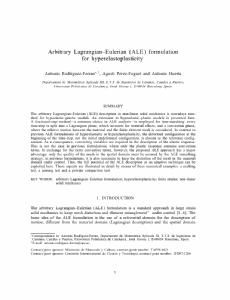Mostra el registre d'ítem simple
Arbitrary Lagrangian-Eulerian (ALE) formulation for hyperelastoplasticity
| dc.contributor.author | Rodríguez Ferran, Antonio |
| dc.contributor.author | Pérez Foguet, Agustí |
| dc.contributor.author | Huerta, Antonio |
| dc.contributor.other | Universitat Politècnica de Catalunya. Departament d'Enginyeria Civil i Ambiental |
| dc.date.accessioned | 2010-07-20T08:20:34Z |
| dc.date.available | 2010-07-20T08:20:34Z |
| dc.date.created | 2002-02 |
| dc.date.issued | 2002-02 |
| dc.identifier.citation | Rodríguez, A.; Pérez, A.; Huerta, A. Arbitrary Lagrangian-Eulerian (ALE) formulation for hyperelastoplasticity. "International journal for numerical methods in engineering", Febrer 2002, vol. 53, núm. 8, DOI i text: The definitive version is available at http://www3.interscience.wiley.com/journal/89011374/abstract, p. 1831-1851. |
| dc.identifier.issn | 0029-5981 |
| dc.identifier.uri | http://hdl.handle.net/2117/8255 |
| dc.description.abstract | The arbitrary Lagrangian-Eulerian (ALE) description in non-linear solid mechanics is nowadays standard for hypoelastic-plastic models. An extension to hyperelastic-plastic models is presented here. A fractional-step method - a common choice in ALE analysis - is employed for time-marching: every time-step is split into a Lagrangian phase, which accounts for material effects, and a convection phase, where the relative motion between the material and the finite element mesh is considered. In contrast to previous ALE formulations of hyperelasticity or hyperelastoplasticity, the deformed configuration at the beginning of the time-step, not the initial undeformed configuration, is chosen as the reference configuration. As a consequence, convecting variables are required in the description of the elastic response. This is not the case in previous formulations, where only the plastic response contains convection terms. In exchange for the extra convective terms, however, the proposed ALE approach has a major advantage: only the quality of the mesh in the spatial domain must be ensured by the ALE remeshing strategy; in previous formulations, it is also necessary to keep the distortion of the mesh in the material domain under control. Thus, the full potential of the ALE description as an adaptive technique can be exploited here. These aspects are illustrated in detail by means of three numerical examples: a necking test, a coining test and a powder compaction test. |
| dc.format.extent | 21 p. |
| dc.language.iso | eng |
| dc.publisher | Wiley and Sons |
| dc.rights | Attribution-NonCommercial-NoDerivs 3.0 Spain |
| dc.rights.uri | http://creativecommons.org/licenses/by-nc-nd/3.0/es/ |
| dc.subject | Àrees temàtiques de la UPC::Matemàtiques i estadística::Anàlisi numèrica::Mètodes numèrics |
| dc.subject.lcsh | Solids--Mechanical properties |
| dc.subject.lcsh | Nonlinear mechanics--Mathematical models |
| dc.subject.other | Arbitrary Lagrangian-Eulerian formulation |
| dc.subject.other | Hyperelastoplasticity |
| dc.subject.other | Finite strains |
| dc.subject.other | Non-linear solid mechanics |
| dc.title | Arbitrary Lagrangian-Eulerian (ALE) formulation for hyperelastoplasticity |
| dc.type | Article |
| dc.subject.lemac | Mecànica no lineal |
| dc.subject.lemac | Mecànica dels sòlids |
| dc.contributor.group | Universitat Politècnica de Catalunya. LACÀN - Mètodes Numèrics en Ciències Aplicades i Enginyeria |
| dc.identifier.doi | 10.1002/nme.362 |
| dc.description.peerreviewed | Peer Reviewed |
| dc.rights.access | Open Access |
| local.identifier.drac | 672352 |
| dc.description.version | Postprint (author’s final draft) |
| local.citation.author | Rodríguez, A.; Pérez, A.; Huerta, A. |
| local.citation.other | DOI i text: The definitive version is available at http://www3.interscience.wiley.com/journal/89011374/abstract |
| local.citation.publicationName | International journal for numerical methods in engineering |
| local.citation.volume | 53 |
| local.citation.number | 8 |
| local.citation.startingPage | 1831 |
| local.citation.endingPage | 1851 |
Fitxers d'aquest items
Aquest ítem apareix a les col·leccions següents
-
Articles de revista [3.002]
-
Articles de revista [589]


